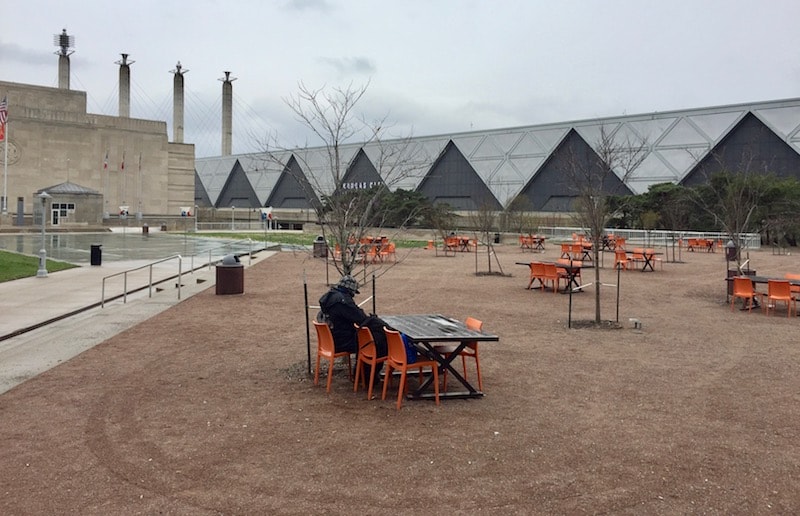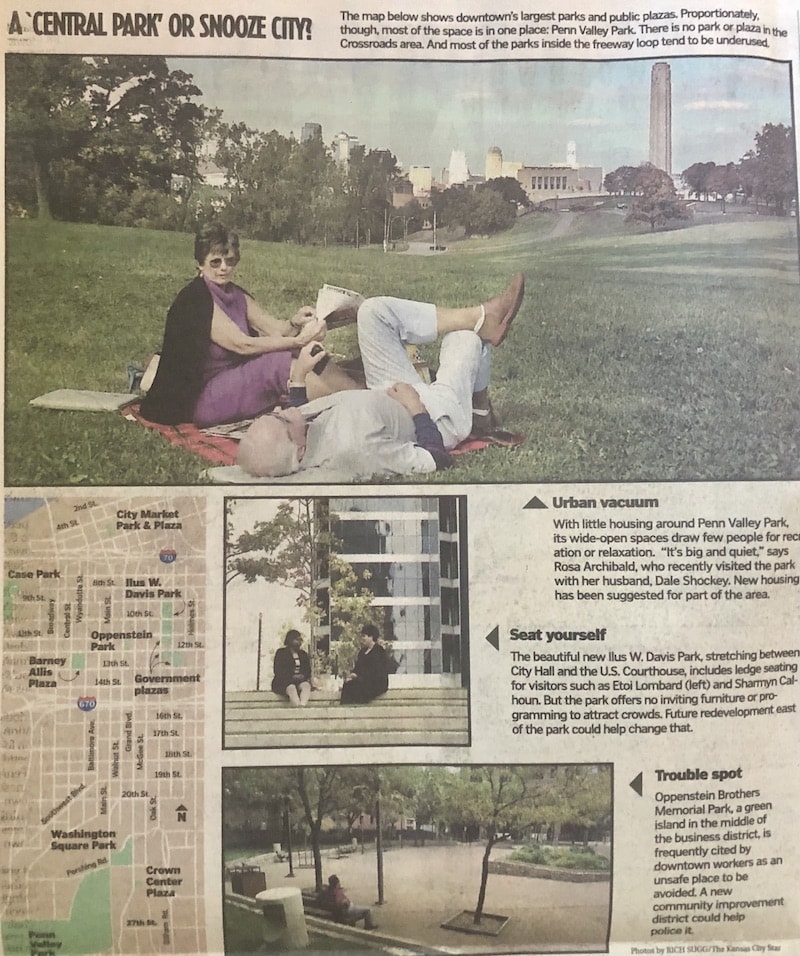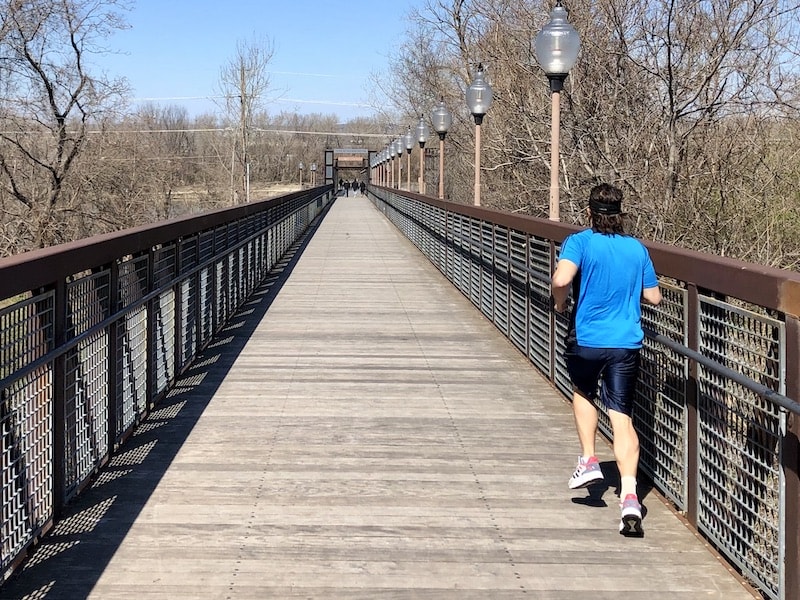Mending Our Broken Heart: Roots of Revival: Safety, Cleanliness, Nature (Part 2)

Published October 14th, 2022 at 11:30 AM
“Downtown KC: Mending Our Broken Heart,” was a groundbreaking series originally published by The Kansas City Star 20 years ago this month.
It was written by former staffers Jeffrey Spivak, Kevin Collison and Steve Paul, with photographs by Rich Suggs. It was edited by former deputy national editor Keith Chrostowski.
CityScene KC thanks The Kansas City Star and Mike Fannin, its president and editor, for granting permission to republish this report.
While The Star retained the text of “Mending Our Broken Heart,” the original photos and graphics were unavailable. Photos of that missing material from a reprint of the series were used as much as possible.
It was lunch hour on a glorious, sunny October day, and at Washington Square Park near Crown Center and Union Station, the few picnic tables there were empty.
About a mile to the north, at the new Ilus W. Davis Park featuring a circular reflecting pool across the street from City Hall’s north door, just four persons sat on the ledges surrounding the pool.
At midafternoon on a Saturday on another gorgeous October day, when soccer and baseball players filled parks all over suburbia, the ball fields at Penn Valley Park were vacant.
In Kansas City’s 2000 citizens survey, about half the respondents who lived in the 2nd Council District – encompassing all of downtown at that time – indicated they seldom visited any city parks.
Peter Callan lives at Crown Center and used to go running at Penn Valley, until a trail west of Broadway crumbled.
“It frustrates me greatly,” says the health-care consultant. “It’s so annoying to go to a Chicago or a Denver or a Dallas, and you can stay at a downtown hotel and within five minutes you’re at a nice trail, but we have nothing.”
The fact is our downtown has plenty of park space, but much of it is not in the right places, and some it is not well designed for what downtown needs today.
About 90 percent of the acreage is in one place, Penn Valley, at the edge of downtown. And because Penn Valley is so large, our downtown has more park acreage than any of Kansas City’s 16 peer cities. Yet, we’re in the middle of the pack among our peers in the number of green-space parks downtown, with five. Milwaukee has seven. Cincinnati has six. Several other cities have five.
The New York-based Project for Public Spaces researched parks around the world. Its handbook notes, “Today, many public spaces seem to be intentionally designed to be looked at but not touched.”
That seems to be the case in our downtown, local urban planners say.

Barney Allis Plaza was described in a 2018 report by the Urban Land Institute as an unwelcoming place.
Barney Allis Plaza is high off the street on three sides, so visitors can’t see inside and decide whether they want to venture there. Davis Park sports no chairs or benches. Washington Square’s trees take up much of the open space.
“We have too many examples, especially around downtown, of parks that by themselves can be largely vacuums,” says Daniel Serda, executive director of the Kansas City Design Center. “Open space can very easily become dead space.”
Across the country, park planning is shifting: Parks should no longer only be refuges from the city’s bustle. They should instead add bustle.
“We are ushering in the ‘smart park,’ a more intensive, less pastoral park, an entertainment venue, a magnet for activity,” says Joe Brown, president of California-based EDAW Inc., one of the country’s leading park planning companies.
So downtown Kansas City’s new blueprint, called the Sasaki plan after the Boston-based consulting company that created it, advocates adding several more parks – but small ones that serve a purpose.
One would occupy part of a block at Ninth and Wyandotte streets, close to hundreds of new lofts around the relocated public library. Another would be part of a block at Grand and 20th Street, close to apartments being developed in the Crossroads.
The Sasaki plan also reiterates the city’s FOCUS master plan and calls for a square-block park southwest of Main and 18th streets, in the middle of the Crossroads. It’s intended to provide a genteel setting for surrounding real estate development.
“Balancing real estate with parks is a good way to create investment and add value and contribute to a sense of place,” says Kathryn Madden, the main Sasaki planner.
What the Sasaki plan doesn’t do is suggest how to enliven the new parks.
A few cities have basketball courts in downtown parks. One of Nashville’s has a jogging trail. Cleveland’s Public Square is stocked with statues and fountains. Louisville even opened a riverfront skateboard park downtown – a marked contrast to Mayor Barnes’ recent bashing of skateboarders who use Barney Allis.

Graphic from “Downtown KC: Mending Our Broken Heart” series courtesy The Kansas City Star
Moreover, downtown parks and squares in Kansas City’s peer cities play host to concerts and festivals during the summer. Milwaukee, for instance, throws an ethnic festival every weekend at one park and has weekly concerts at another. Here, Penn Valley could be used more often as an event setting – especially on the north slope with its skyline view.
So what about the rest of sprawling Penn Valley? One idea is to use some of those 176 acres for housing.
Architect Mark Viets, at the urging of downtown executives overseeing the struggling Union Station, has proposed using 10 acres between Kessler Drive and Broadway, along with 10 more privately owned acres, for low-rise apartment buildings.
That could mean 1,000 units. The land could be leased from the city’s parks board, thus providing revenue for park improvements. This would boost downtown’s population, and it would help add customers for Union Station, Crown Center and the rest of downtown.
“Someday, if the expansion of downtown residential proves to be successful, this is something that could be considered,” says Bob Lewellen, a city parks commissioner and former city councilman.
Making connections
Great cities are walking cities. As part of their sense of place, they offer surprising things to see and do.
That sense is strong in some downtown districts: the growing River Market, the eclectic and creative Crossroads.
It’s strong in pockets, such as the Garment District, parts of Quality Hill and the renovated Freight House, where you can dine outdoors, watch trains go by and view public art projects such as James Woodfill’s light sculptures, which celebrate the city’s railroad heritage.
Yet, all those sites are spread out, like having cuffs and collars and hems but no sleeves.
Theorists today say good urban design is about making things connect, and creating a sense of place all over downtown, instead of in just a few islands.
It means having shop windows to look in, or sidewalk cafes, or any number of diverse activities that give people a reason to walk the streets and mingle and linger.
“Large projects are really important,” says architect David Dowell, but “equally important are 10 small projects.”
The small things help connect the large ones. They make a city interesting.
Connections can be both physical and mental, dignified and surprising, indigenous and novel. Some are simple, and some take imagination.
Here are some of the ideas and suggestions being discussed in the community about how downtown could make such connections:
–We could create more pleasant, walkable streets, with trees and other features.
The Sasaki plan calls for planting trees along Grand, Main and Wyandotte, plus Ninth, 12th, 18th and Southwest Boulevard – on both sides of the streets, not just one.
Along Wyandotte and Central streets, streetscape enhancements would further the goal of creating an “Avenue of the Arts,” which could link Union Station, the performing arts center and points north. Downtown streetscaping, in fact, could get a boost from a city bond issue on the November ballot.
Local architect Cindy Frewen was in downtown Charlotte, N.C., recently, where she noticed herself favoring the tree-shaded sides of the streets.
“It’s an appearance upgrade, and it makes people feel better when they’re walking down the streets,” says Frewen, who helped work on Kansas City’s downtown Sasaki plan.
–We could re-engage with the riverfront.
Milwaukee, Cincinnati and other cities have begun to revive their relationships with their major rivers. Kansas City has long turned its back on its most historic natural resource.

The Town of Kansas Bridge is a pedestrian span extending to the riverfront from the foot of Main Street.
But recently the city opened a new pedestrian bridge, at Second and Main streets. For the first time in years, someone can easily walk from the City Market to an overlook for a close-up view of the Big Muddy.
Other riverfront elements include a Heritage Trail system, already under way; a 17-acre wetlands area; and a stalled Town of Kansas archaeological site and interpretive center, which will help tell the story of the city’s riverside origins.
The river “was the center of possibility then, and it is today,” says Bill Johnson, chairman of the city’s Port Authority.
–We could continue our creativity with public art.
We are a city of sculpture, from the Nelson’s shuttlecocks to Bartle’s “Sky Stations” to smaller projects all over. Now artistic lampposts and fences are in the works for the Heritage Trail. In the future, if Bartle Hall is expanded, and a new city arena and parking garages are built, more than $4 million would become available for public art under the “1 percent for art” program.
Sometimes, just a little paint will do. For instance, two large black smokestacks tower northeast of the City Market. Why not turn them into a nameplate? “River” on one, “Market” on the other.
“Sense of place,” says landscape architect Patti Banks, who has an office at the north end of Main Street. “That’s an easy thing to do.”
–We could be more creative in using the city’s strengths.
Marketers talk of “branding” products, and Kansas City has several to choose from: City of Fountains and Boulevards. City of Barbecue. City of Jazz.
Downtown leaders should keep those brands in mind, planners say.
For example, conventioneers lament the lack of downtown dining. Maybe downtown should encourage a barbecue district. Just like Folgers has filled part of downtown with the aroma of coffee, a cluster of barbecue restaurants could send the aroma of smoked meats wafting into the air.
Or what about playing up Kansas City in song? In Chattanooga, Tenn., the lyrics and sheet music of “Chattanooga Choo-choo” are inscribed in a band of pavement. Wouldn’t it be fun to see the lyrics of “Goin’ to Kansas City” on 12th Street?
One of the city’s strongest resources is its rich history. It’s told in pieces in small museums around the area. A downtown attraction could knit together all the strands. As Union Station leaders consider using local history to shore up the station’s future, they might look for inspiration to St. Louis’ Museum of Westward Expansion. What about a museum of the American West here?
Such ideas appeal to Matt Madden, who works in Johnson County. He grew up on the Missouri side. He loves Kansas City and doesn’t intend to leave. But when friends visit, he wants to be able to take them downtown.
He wants a downtown that looks nice, a downtown with events going on in a park, a downtown with a great museum.
“I would like,” the 26-year-old says, “a downtown to be proud of.”
THE POLL
As part of the reporting for this series, The Star in conjunction with Market Research Institute Inc. polled adults in the five-county Kansas City area. A total of 608 interviews were conducted. Here are some of the responses regarding trashy streets, blighted buildings and parks. What does downtown need?
1. Something done with vacant buildings?
Yes 98%
No 2%
2. Cleaner streets?
Yes 77%
No 23%
3. More parks?
Yes 52%
No 48%
When looking at the poll results in total, the margin of error, at a 96 percent confidence level, is plus or minus 4 percentage points. That means that if this study had been repeated under the same circumstances 100 times, the results for each question would not vary by more than 4 percentage points in 96 of the 100 times the study was conducted.


